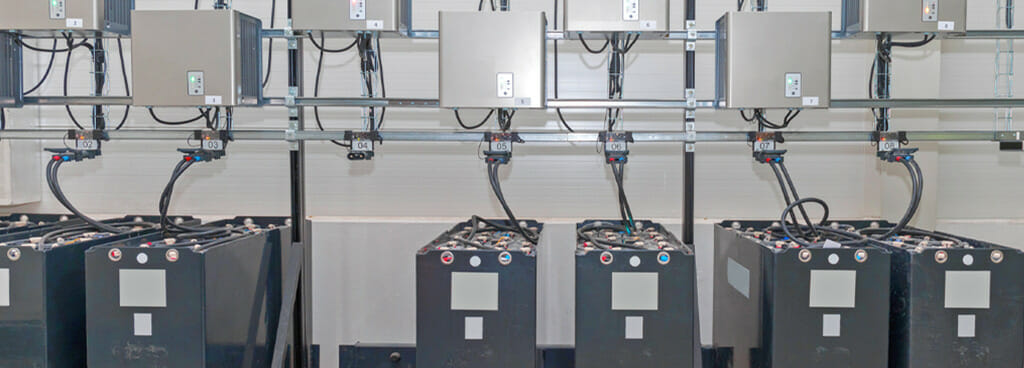- Home
- Services/IndustriesServicesindustries
- About Us
- LocationsStatesAccordion ContentAccordion ContentAccordion ContentAccordion Content
- Job Openings
- Quick Links
- ATS Family

SAE J2185 Life Testing for Heavy-Duty Storage Batteries
The Applied Technical Services Family of Companies (FoC) offers A2LA-accredited lab services to help manufacturers meet the stringent requirements of on-road and off-road machinery with SAE J2185 life testing for heavy-duty storage batteries. Published by the Society of Automotive Engineers (SAE), this standard informs manufacturers how discharging and recharging cycles affect the long-term performance of heavy-duty batteries used to start engines.
What are Heavy-Duty Batteries?
Heavy-duty batteries are sometimes called SLI batteries for their role in starting, lighting, and ignition. A vehicle battery discharges a short burst of high current to start the ignition process in an engine. This brief discharge drains a portion of the battery’s capacity. To power the rest of the journey, the battery needs a large capacity for extra power and stabilization until recharging.
Heavy-duty batteries must deliver higher levels of power and deeper discharge levels than typical batteries to drive large commercial trucks and rugged machinery for construction and agriculture. Life testing helps manufacturers design batteries fit for the harsh environments and stringent demands of modern equipment:
- Long operating time over long distances
- Heavy loads
- Vibrations
- Frequent starts and stops
- High temperatures
SAE Life Cycle Testing
The SAE J2185 standard outlines testing procedures to determine a battery’s cycle life, which measures how many times a battery can be successfully discharged and recharged until degrading. ATS FoC experts use this procedure to calculate the battery’s life in ampere-hours.
The experts at our A2LA-accredited battery testing lab regularly perform electrical and mechanical tests on lead-acid batteries. The standard recommends subjecting the battery to harsher conditions than usual to take the battery to its limits through deep discharge cycles, charging cycles, and more extreme temperatures. We use powerful equipment capable of delivering the following conditions:
- 0 to 750 voltage (V) range
- -60 ˚C to 120 ˚C ambient temperatures
- -1000 to 1000 amperage (A) range
- 5 ˚C to 90 ˚C water baths
SAE J2185 Conditioning
Before testing, our experts pre-condition the lead-acid sample in a water bath to reach the high temperatures expected during real-life operations. The temperatures SAE J2185 requires are well within our accredited range. Our conditioning equipment can maintain a temperature of 50 ˚C (122 ˚F) before we subject the battery to a weekly charge/discharge cycle. SAE J2185 differentiates the batteries used in the life test by Battery Council International (BCI) categories:
- Batteries with a reserve capacity less than or equal to 250 minutes
- Batteries with a reserve capacity greater than 250 minutes
SAE J2185 Procedure
We charge and discharge the batteries at different currents and amperages based on their BCI categories and designs. After 26 complete charge/discharge cycles, we can rest the battery on an open circuit then discharge at a cold cranking amperage (CCA) rate. The cold cranking procedure simulates starting an engine after a long rest period. We continue the weekly cycle until the battery cannot meet the pre-determined discharge requirements, signifying that the battery has degraded beyond a useful capacity.
Testing lead-acid batteries at high temperatures raises potential safety hazards. When subjecting batteries under test to extreme conditions, our experts work in a hardy lab designed to contain explosions, vent fumes, and douse fires should a battery begin thermal runaway.
About ATS FoC
The ATS Family of Companies is a network of high-performing companies that promote service excellence, safety, and standard compliance. With experts and labs placed from coast to coast, we are uniquely situated to reach clients with a wide range of needs. We provide consulting engineering, calibration, inspection, and testing services both in-person and from several labs accredited by A2LA to perform calibrations and mechanical, electrical, chemical, and nondestructive tests.
To learn more about our accreditations, click here.
Contact Us
Please call +1 (888) 287-5227 or complete the web form to request battery testing from the ATS FoC.

Request Form
"*" indicates required fields
Battery Testing Links
- Abuse Testing Lithium Ion Batteries
- Battery Abuse Testing
- Battery Chemical Analysis
- Battery Durability Testing
- Battery Electrical Testing
- Battery Impact Testing
- Battery Management Systems BMS Testing and Certification
- Battery Performance Testing
- Battery Safety and Certification Testing
- Battery UL Certification
- Battery Vibration Testing
- Chemical Testing EV Batteries
- Electrical Testing EV Batteries
- Electrical Vehicle Battery Testing
- E Mobility Battery Testing
- Energy Storage System ESS Testing and Certification
- E Scooter Battery Testing
- EV Battery Testing Lab
- EV Battery Mechanical Testing
- EV Battery Pack Vibration
- EV Battery Thermal Testing
- High and Low Temperature Testing EV Battery
- Hoverboard Battery Testing
- IEC 60896-21 Stationary Valve-Regulated Lead-Acid Batteries
- IEC 61427 Secondary Cells and Batteries for Photovoltaic Energy Systems Testing
- IEC 62133 Lithium Battery Safety Testing and Certification
- IEC 62133-2 Lithium Ion Battery Testing Certification
- IEC 62619 Secondary Cells and Batteries Containing Alkaline Testing
- Lead Acid Battery Testing
- Mechanical Testing EV Batteries
- Micro Mobility Battery Testing
- PNNL 22010 ESS Performance Testing
- RESS Safety and Abuse Testing
- RTCA/DO-311 Performance Testing Lithium Batteries
- SAE J1798 Performance Rating of EV Battery Modules Testing
- SAE J2185 Life Testing Heavy-Duty Storage Batteries
- Telcordia GR Battery Testing
- Thermal Testing EV Batteries
- UL 1642
- UL Battery Certification
- UL 1973 Battery Testing
- UL 1989 Standby Battery Testing and Certification
- UL 2054
- UL 2271 E Bike Battery Testing and Certification
- UL 2580 Electric Vehicle Battery Testing and Certification
- UL 9540A
- UL 9540 Thermal Runaway In ESS Testing and Certification
- UN 38.3 Testing
- USABC Battery Testing
- Verizon VZ.TPR Battery Testing
